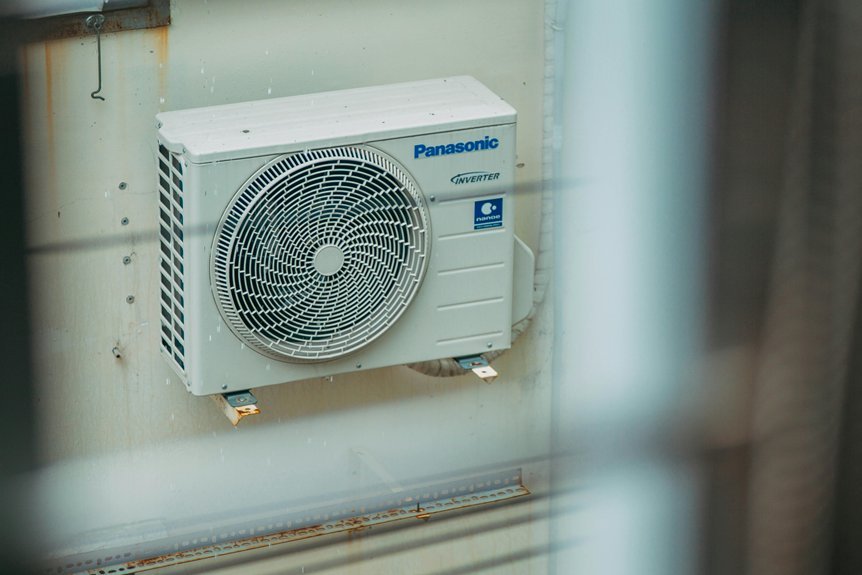While traditional air conditioning systems rely heavily on outdoor units, air conditioners without outdoor units provide a unique solution for space-constrained environments. These compact systems efficiently cool indoor spaces by utilizing refrigerant without requiring external components. Understanding their functionality and benefits can help you decide if this option fits your needs. Let’s explore how these systems work, their advantages, and the ideal settings for their use.
Key Takeaways
- Air conditioners without outdoor units are compact, efficient, and ideal for small spaces like apartments or offices.
- They operate quietly, use less energy, and enhance air quality through advanced filtration systems.
- Installation is straightforward and requires minimal tools, making it accessible for various living environments.
- These systems provide customizable settings for effective temperature control and maintain comfort in diverse room sizes.
- Energy-efficient models help reduce utility bills and offer long-term savings with low maintenance needs.
Understanding Air Conditioners Without Outdoor Units
While traditional air conditioning systems often rely on an outdoor unit to dissipate heat, air conditioners without outdoor units offer a compact and efficient alternative for cooling spaces.
These units are designed for indoor cooling, effectively managing temperature while maintaining superior air quality. They circulate and filter air within the enclosed environment, reducing dust and allergens.
By utilizing advanced technologies, such systems can operate quietly and often use less energy than conventional models. This makes them ideal for small apartments or offices where outdoor installation isn’t feasible.
You’ll appreciate the enhanced comfort and improved air quality in your living or working space.
How These Systems Work
Air conditioners without outdoor units operate through a closed-loop system that efficiently manages indoor temperature and humidity.
These systems utilize advanced technology to optimize airflow dynamics and guarantee effective temperature regulation.
Advanced technology enhances airflow dynamics, ensuring optimal temperature regulation for maximum comfort.
Here’s how they work:
- Air Intake: The unit draws in warm air from the room.
- Cooling Cycle: Refrigerant absorbs heat, cooling the air.
- Air Distribution: A fan circulates the cooled air back into the room.
- Humidity Control: Excess moisture is removed, enhancing comfort.
Key Benefits of Indoor-Only Air Conditioning
Indoor-only air conditioning units offer several advantages that enhance your living space.
Their space-saving design eliminates the need for bulky outdoor units, making them ideal for apartments or homes with limited exterior access.
Additionally, these systems operate quietly and are easy to install, allowing for a seamless integration into your environment.
Space-Saving Design
When you prioritize space in your living environment, opting for an air conditioning system without an outdoor unit provides a sleek and efficient solution.
These compact units boast innovative designs that blend seamlessly into your interior. Here are some key benefits:
- Maximized Space: No bulky outdoor unit means more room for landscaping or furniture.
- Aesthetic Appeal: Modern designs complement your décor without compromising style.
- Easy Installation: Simple setup allows for quick adjustments in smaller spaces.
- Versatility: Suitable for various living environments, from apartments to tiny homes.
Choose an indoor-only system for a functional, space-saving air conditioning solution.
Quiet Operation
Compact air conditioning systems without outdoor units not only save space but also offer a significant advantage in noise reduction. You’ll appreciate the silent operation that these systems provide, creating a comfortable environment without disruptive sounds.
Here’s a quick comparison of noise levels:
| System Type | Noise Level (dB) | Ideal Use Case |
|---|---|---|
| Central Air System | 70-80 | Whole-house cooling |
| Window Unit | 50-60 | Single room cooling |
| Indoor-Only Unit | 30-40 | Apartments/offices |
With these systems, you can enjoy cooling without the constant hum of traditional units.
Easy Installation
One of the standout benefits of air conditioners without outdoor units is their straightforward installation process. You’ll appreciate the quick setup that requires minimal tools, making it accessible even for DIY enthusiasts.
Here’s what you can expect during installation:
- Compact Design: Fits easily in any room without the need for extensive modifications.
- Lightweight Components: Simplifies handling and positioning.
- No Refrigerant Lines: Eliminates the need for complex plumbing.
- User-Friendly Instructions: Most units come with clear, step-by-step guides.
Installation Process and Requirements
Before you begin the installation of an air conditioner without an outdoor unit, it’s essential to assess the space where the unit will be placed.
Follow the installation guidelines closely, confirming you have the necessary tools, such as a drill, level, and screwdrivers.
Start by marking the mounting bracket location, then drill holes for anchors. Secure the bracket, and attach the unit according to the manufacturer’s instructions.
Verify proper electrical connections and test the system for functionality.
Remember to check for adequate airflow and make any adjustments as needed to optimize performance.
Comparing Efficiency and Costs
When evaluating air conditioners without outdoor units, you need to take into account energy consumption, installation costs, and long-term savings potential.
These units often offer higher energy efficiency ratings, which can greatly reduce your monthly utility bills.
Additionally, while initial installation expenses may vary, the overall investment can lead to considerable savings over time.
Energy Consumption Analysis
As energy efficiency becomes increasingly essential in modern HVAC solutions, air conditioners without outdoor units present a compelling alternative for cost-conscious consumers. Their unique design allows for reduced energy consumption, adapting to various consumption patterns.
Here’s what you should consider:
- SEER Ratings – Look for units with higher Seasonal Energy Efficiency Ratios for ideal performance.
- Power Usage – Monitor energy usage during peak hours to avoid spikes in bills.
- Energy Star Certification – Choose certified models to guarantee efficiency.
- Smart Controls – Utilize programmable settings to enhance energy management.
These factors help maximize energy efficiency while minimizing costs.
Installation Expenses Overview
Understanding the installation expenses of air conditioners without outdoor units is essential for making an informed decision.
Typically, installation costs for these units can vary considerably based on factors like the complexity of the installation, the type of system chosen, and local labor rates.
While you might save on outdoor unit placement, you’ll need to factor in potential structural adjustments or electrical upgrades.
Financial considerations also include the initial purchase price versus efficiency ratings, as higher efficiency units may have a steeper upfront cost but yield better long-term performance.
Balancing these elements will help you make the best choice for your needs.
Long-term Savings Potential
After considering installation expenses, it’s important to evaluate the long-term savings potential of air conditioners without outdoor units.
These systems can be a smart long-term investment, offering various benefits that influence your cost analysis:
- Higher Energy Efficiency – These units often have superior SEER ratings, reducing electricity costs.
- Lower Maintenance Costs – With fewer components exposed to the elements, maintenance is typically less frequent and cheaper.
- Increased Lifespan – Indoor units can last longer due to minimized wear from outdoor conditions.
- Flexible Installation – You can place units in multiple spaces, enhancing cooling efficiency throughout your home.
Ideal Situations for Indoor Air Conditioning Solutions
While many people think of traditional air conditioning systems with bulky outdoor units, there are several ideal situations where indoor air conditioning solutions shine.
If you live in a compact space like an apartment or a studio, these systems can optimize your indoor climate without sacrificing valuable outdoor space.
In urban areas with strict regulations, you’ll appreciate their discreet installation.
Additionally, if maintaining air quality is a priority, indoor units often have advanced filtration systems that enhance your environment.
These solutions provide efficient cooling while ensuring cleanliness, making them perfect for anyone seeking comfort and improved air quality in their living spaces.
Conclusion
In the domain of indoor comfort, air conditioners without outdoor units are like silent guardians, tirelessly battling the heat while protecting your living space. As you embrace this sleek solution, you’re not just investing in a cool breeze; you’re fostering an environment where efficiency and tranquility reign. Whether it’s a cozy apartment or a bustling office, these systems weave comfort into your daily life, ensuring every corner stays invigoratingly cool without the burden of outdoor installations.



